In 1975, higher-denomination coins like the Quarter, Half Dollar, and Dollar were minted with dual dates (1776–1976) to commemorate the 200th anniversary of American independence. However, the Lincoln cent was not included in this celebration because it was first issued in 1909 to honor the 100th birthday of Abraham Lincoln. As such, its own bicentennial celebration took place in 2009.
In the meantime, here’s a breakdown of the estimated value of 1975 Lincoln pennies depending on their condition:
1975 Penny Value Chart
| Coin | MS 63 RD | MS 65 RD | MS 67+ RD | MS 68 RD | PR/PF 69 DCAM |
|---|---|---|---|---|---|
| 1975 No Mint Mark Penny | $3 | $16 | $650 | $10,500 | – |
| 1975-D Penny | $7 | $16 | $900 | $10,000 | – |
| 1975-S Proof Penny | – | – | – | – | $34 |
History of the 1975 Penny

The 1975 Lincoln penny features the Lincoln Memorial on its reverse. As mentioned earlier, this coin was originally introduced in 1909 to celebrate the centennial of Abraham Lincoln’s birth. Then, in 1959, the U.S. Mint updated the coin to mark the 150th anniversary of Lincoln’s birth by replacing the original wheat ears design with the Lincoln Memorial.
This new reverse design remained in use until 2008, after which it was replaced with four special reverse designs in 2009 to celebrate Lincoln’s 200th birthday. In numismatics—the study and collection of coins, medals, and tokens—the obverse is the front (heads side), and the reverse is the back (tails side). Coin collectors and scholars in this field are known as numismatists.
Interestingly, some 1975 pennies were struck in aluminum. The Mint had tested aluminum as a coin metal once before in 1942, during World War II, as they searched for alternatives to copper and nickel, which were needed for military purposes. In the mid-1970s, the cost of copper began to climb, making it nearly as expensive to produce a penny as its face value—an issue since pennies were typically the Mint’s most profitable coin.
Aluminum Cents and the Role of West Point
Aside from the aluminum experiment, West Point Mint began minting pennies in 1974, continuing through 1986. However, these coins had no mint mark, so they were often mistaken for those made in Philadelphia. It wasn’t until 2019 that the West Point Mint started marking coins with a “W” to commemorate 110 years of the Lincoln cent.
Currently, 66 aluminum cents from 1975 are believed to exist, while about 10 from 1974 have surfaced, despite the Mint having struck nearly 1.6 million of them in that year. Most of the 1974 and 1975 aluminum coins were meant to be destroyed after Congress rejected the switch from copper, but a handful slipped into private collections. These coins were made primarily from aluminum with small traces of other metals added for strength.
By 1982, the Mint adopted a new composition: 97.5% zinc coated in 2.5% copper, giving the penny its traditional reddish color. However, even with this cheaper alloy, it now costs nearly 3 cents to produce a single penny—more than its face value. Still, the penny remains a symbol of American coinage and the first to feature a president, and the Mint currently has no plans to discontinue it.
Features of the 1975 Lincoln Penny
Beyond the front (obverse) and back (reverse) of the 1975 penny, there are a few more numismatic terms to understand. The thin outer part of the coin is known as the edge. Unlike other coins that have grooved or reeded edges, the penny’s edge is smooth. The slightly raised outline around the coin is called the rim or sometimes the collar.
The inscriptions on the coin—like “IN GOD WE TRUST” or “LIBERTY”—are known as legends or mottos, while the design elements, such as Lincoln’s portrait or the Lincoln Memorial, are referred to as devices. The flat background area surrounding the devices is called the field. Finally, before a coin is struck with a design, the blank metal disc it starts out as is called a planchet.
The Obverse of the 1975 Penny
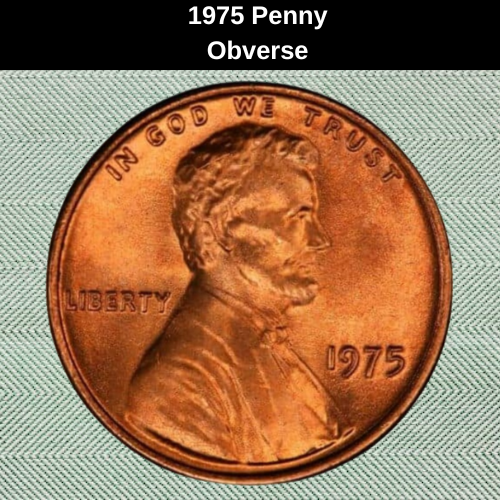
The obverse of the coin features a right-facing portrait of Abraham Lincoln. Above his head is the national motto, “IN GOD WE TRUST.” To the left, positioned behind Lincoln’s back, is the word “LIBERTY.” On the right side of the coin—just in front of his chest—you’ll find the year of minting along with the mint mark, if present. At the base of Lincoln’s shoulder, you’ll notice the initials “VDB,” a tribute to the coin’s designer, Victor David Brenner.
The Reverse of the 1975 Penny
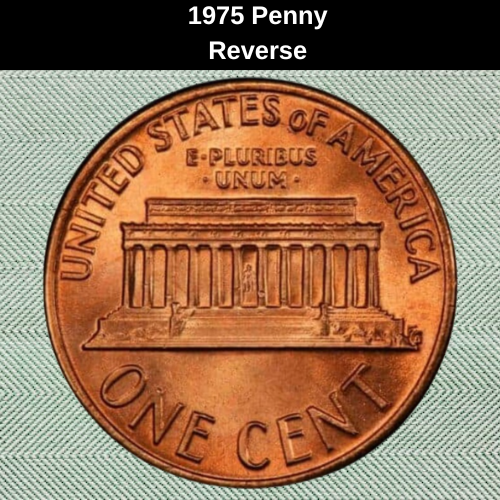
The reverse of the 1975 penny displays the Lincoln Memorial at its center. If you look closely between the central columns, you can make out the faint image of Lincoln’s seated statue inside the structure. Arched across the top are the words “UNITED STATES OF AMERICA,” with the motto “E PLURIBUS UNUM” directly beneath it. At the bottom of the coin is the denomination, “ONE CENT.” In the lower right, the initials “FG” appear, honoring Frank Gasparro, the artist behind the reverse design.
Additional Characteristics of the 1975 Penny
While a few experimental pieces were made from aluminum, the majority of 1975 pennies were composed of 95% copper and 5% zinc and/or tin. This coin represents the fourth design in the small cent series, with a diameter of 19.05 mm (0.75 inches) and a standard weight of 3.11 grams. Pennies are often the most popular starting point for new collectors due to their widespread availability and low cost, making them ideal for entry-level numismatists.
Grading the 1975 Lincoln Penny
Although the Lincoln Cent has featured the same front (obverse) design since its debut, it has undergone seven different reverse designs over the years. Because these coins are made of copper, they’re also evaluated based on color grading, which reflects how much red luster remains. The brightest coins are labeled RD (Red), followed by RB (Reddish-Brown), and finally BN (Brown) — though this color classification excludes special issues like steel cents (1942–1944) and aluminum cents (1974–1975).
Grading Scale Overview (Sheldon Scale):
| Grade Number | Description |
|---|---|
| 1 | Basal State-1 |
| 2 | Fair |
| 3 | Very Fair |
| 4–6 | Good |
| 7–10 | Very Good |
| 12–15 | Fine |
| 20–30 | Very Fine |
| 40 | Extremely Fine |
| 50 | About Uncirculated |
| 60 | Mint State (MS) |
| 65 | Gem Mint State (MS65) |
| 70 | Perfect Mint State |
If you want to know the true value of your 1975 penny, the first step is accurate grading. Be sure to consult a reliable coin grading guide to determine where your coin fits on the scale.
1975 Penny Value Overview
Although 1975 wasn’t a particularly remarkable year for pennies, they gained some extra attention thanks to the buzz surrounding the Bicentennial Coinage. Collectors eager for the special 1976 coins—marked with the dual dates “1776–1976”—also showed interest in other coins from around that time. However, since the Mint prioritized the production of these commemorative coins, the quality of 1975 pennies generally suffered. As a result, coins in high grades from 1975 are relatively scarce and therefore carry a premium among collectors.
1975 No Mint Mark Penny Value
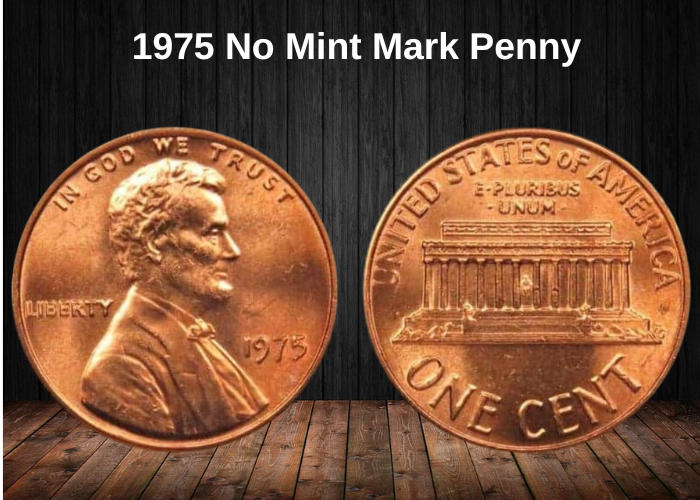
During 1975, the U.S. Mint struck over 5.4 billion pennies that did not bear any mint marks. Of these coins, about 3.87 billion were produced at the Philadelphia Mint, while the West Point facility contributed roughly 1.58 billion coins. Although a small batch of 66 aluminum pennies was also created that year, these were mostly destroyed and are extremely rare today.
On April 29, 2018, one of these pennies in a Mint State 68 Red condition fetched $9,000 at auction. According to the Professional Coin Grading Service (PCGS), only four specimens of this type have been documented, with their 2023 market value projected to be around $10,500.
1975-D Penny Value
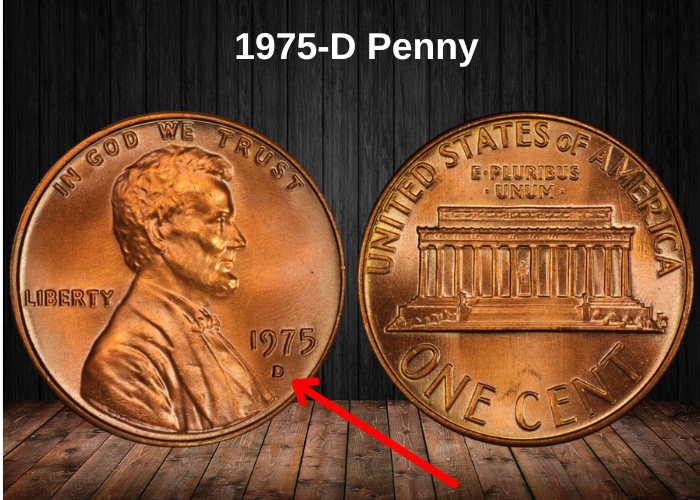
In 1975, the Denver Mint produced approximately 4.5 billion pennies marked with the “D” mint mark. On March 21, 2014, a Mint State 67+ specimen sold for a record price of $4,113. Since then, PCGS has graded a total of seven coins at MS 67+, which has caused the estimated value for this grade to decrease to about $950 as of July 2023. However, only one MS 68 coin has been graded by PCGS, and its current estimated worth is around $10,000.
1975-S Proof Penny Value
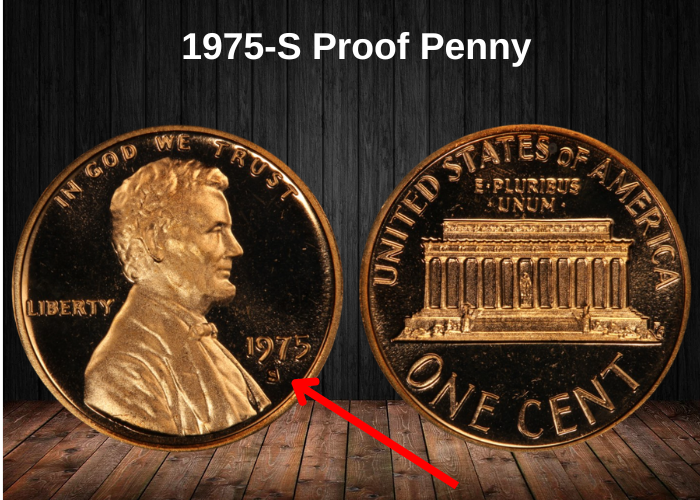
Starting in 1971, proof coins were made using a new method that replaced acid pickling with computerized laser frosting to create the hazy areas. The coin’s field kept its mirror-like polish, achieved by cleaning the dies with horsehair brushes and polishing the blanks with stainless steel balls before minting. The year 1975 was significant for the San Francisco Mint.
In 1975, the San Francisco Mint switched exclusively to producing proof coins. That year, it struck 2,845,450 proof pennies with the “S” mint mark. On January 17, 2022, an NGC-graded PF 69 RD Ultra Cameo sold on eBay for $250. It’s important to note that NGC uses the grade PF for proof coins, while PCGS uses PR. Also, an Ultra Cameo (NGC) is equivalent to a Deep Cameo (PCGS).
These coins show the strongest contrast between the frosted design and the mirrored background. Rarity also affects price: only two PF 69 RD Ultra Cameos are known, while nearly 2,000 PR 69 Deep Cameo coins exist. In July 2022, a PR 69 DCAM was worth $1,150 but dropped to about $55 in July 2023. Meanwhile, the single PR 70 DCAM is valued at $15,000 as of July 2023.
Rare 1975 Penny Errors Overview
One of the most frequent penny errors is a wrong planchet, where a 1-cent coin is struck on a blank intended for a different denomination (like a penny on a nickel blank, or a dime on a cent blank). Other common mistakes include misalignment, multiple strikes, cud breaks, die clashes, die caps, and strike-throughs. Below are some notable 1975 penny errors and their approximate values.
1975-D Penny Struck Through Capped Die Cap
At the mint, coin blanks move along a conveyor system guided by feeder fingers. Occasionally, a blank can get stuck on the die, obstructing the next coin’s imprint and causing a weak or blurry design on that coin’s lower side. This error is known as a capped die or die cap. An example graded MS 62 by NGC sold for $53.
1975-D Penny Obverse Die Cap Error
A rarer and more valuable variant of the capped die error. Instead of the back being blurry, on this coin the obverse (heads side) remains sharp, while the reverse (tails side) is hazy. The die cap presses the coin into a slight concave or saucer-shaped dent on the heads side, curving outward on the back. This error in MS 65 RB condition sold for $360.
1975-D Penny Major Die Break
Each mint die produces thousands, sometimes hundreds of thousands of coins before it begins to wear down. Over time, the die can develop cracks and chunks missing, known as cuds or die breaks. These flaws transfer onto the coin, showing as small scooped-out areas where the metal flowed into the cracks. A major cud break on a 1975-D penny graded MS 64 RB can fetch around $54.
1975-D Penny Double Strike Broadstruck Off-Centre
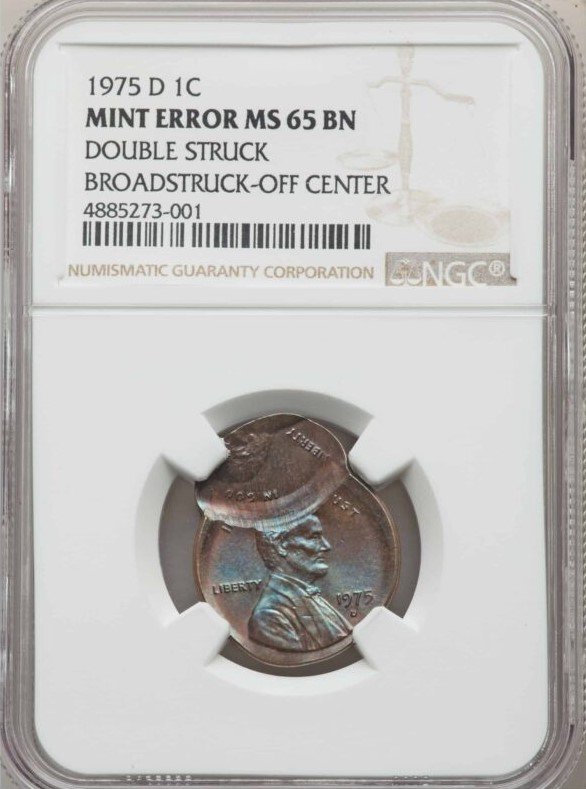
To guarantee that every detail appeared clearly on a coin, the planchet was usually struck two or more times. If the planchet shifted during the first strike, it caused a misalignment, leaving part of the coin blank. However, if the slip happened during the second or third strike, it resulted in overlapping images or distorted coins. For example, an 80% off-center penny graded MS 62 sold for $60, while a broadstrike penny graded MS 65 BN was valued at $168.
1975-D Penny Triple Struck Error
As mentioned earlier, an off-center error with about 5% of the planchet empty can be worth around $51. Likewise, a small die break may range between $35 and $50. Regarding multiple strike errors, the size and severity affect the value. This MS 63 RN example shows three distinct overlaps from the lower right to the upper left. The top strike is upside down, making it a dramatic flaw. This error sold for $188.
1975 Penny Fold-Over Error
The die strikes the coin with great force. If the planchet doesn’t lie flat when it enters the press, it can get folded in half, resulting in a fold-over error. The coin ends up partially printed and shaped like a half circle, with parts of the design cut off. A specimen certified as genuine by NGC sold for $575, while one graded MS 65 RB sold for $1,495.
1975 Penny Struck on a Dime Planchet

We previously mentioned wrong planchet errors, where the diameter, weight, and metal composition clearly don’t match a penny. In this case, the penny was struck on a dime planchet, giving it the distinctive silver color and causing parts of the lettering to be cut off because pennies measure 19.05mm while dimes are 17.91mm in diameter. A 2.3g coin graded MS 61 sold for $305, and a 2.5g coin graded MS 65 fetched $900.
1975 Penny Strike-Thru Detached Lamination
Coins are made of layers of metal, and when these layers separate during minting, it’s called a lamination error. Coins with multiple errors are usually more valuable. This penny has a detached metal layer that shifted onto the coin beneath, blocking the surface, causing an overstrike, and damaging the design. In MS 62 BN, it’s valued at $161.
1975 Penny Double Denomination Error
A wrong planchet error happens when a coin is struck on the incorrect blank. But a double denomination error occurs when a coin’s design is struck over another already stamped coin, combining features of two different coins. This example shows a 1975 Penny struck over a 1975 Roosevelt Dime, with both presidents clearly visible. In MS 66, it sold for about $978.
1975-D Penny Mated Pair Error
A mated pair or bonded pair consists of two error coins sold together. This can happen with a capped die pair—where one coin is stuck on the die and the next is blocked—or two off-center coins with overlapping errors. This particular pair is graded MS 62 BN and MS 64 RB, valued at $750 together.
1975 Penny DDO and DDR Errors
DDO (Doubled Die Obverse) and DDR (Doubled Die Reverse) errors occur when the die shifts slightly between strikes, creating a double image effect on all coins produced with that die. Since these aren’t classified as First Strike (FS), meaning not detected within 30 days of release, their value is modest—around $15 to $30 in MS 65.
1975-D Penny RPM Error
Before digital minting, mint marks were manually added to the master die, leading to mistakes like re-punched mint marks (RPM). This happens when the mint mark is stamped twice in slightly different places, showing a faint duplicate beneath the main mark. These errors are worth about $50 in MS 65.
Where to sell your penny?
Now that you know the value of your penny, you might be wondering where to sell it. Don’t worry: here’s a guide to some of the best online platforms where you can easily sell your coins, along with their advantages and disadvantages.
Discover the best platforms for selling coins online (pros and cons).
1975 Lincoln Penny FAQ
1. What is the general value of a 1975 Lincoln penny?
Most 1975 Lincoln pennies found in circulation are worth their face value (1 cent). However, coins in uncirculated condition (MS60 and higher) can range from $0.50 to $5, depending on mint mark and eye appeal.
2. What mints produced the 1975 penny and how many were made?
- Philadelphia (no mint mark): Approximately 4.3 billion minted.
- Denver (D mint mark): Approximately 2.9 billion minted.
- San Francisco (S mint mark, proofs only): Around 9.7 million minted.
High mintage means these coins are common, even in higher grades.
3. Are there any significant error coins or varieties for 1975 pennies?
1975 pennies don’t have widely known dramatic errors like the 1972 DDO, but collectors sometimes find:
- Repunched Mint Marks (RPMs)
- Minor die cracks or breaks
- Off-center strikes
- Clipped planchets or other planchet flaws
These error coins may command modest premiums, generally $10 to $100 depending on condition.
4. How can one differentiate between circulation strikes and proof coins from 1975?
- Circulation strikes were intended for everyday use and show more wear.
- Proof coins (1975-S) were struck with polished dies for collectors, featuring sharp details and mirror-like surfaces.
Proofs in high grades, especially with Deep Cameo contrast, can be worth $15 to $40 or more.
5. What composition does the 1975 penny have, and why is this important?
The 1975 penny is made of 95% copper and 5% zinc and tin, the classic composition used from 1909 until 1982 (except 1943). This makes it heavier and more valuable in metal content compared to later zinc pennies post-1982.
6. How does the 1975 penny fit in the Lincoln Memorial series?
The 1975 penny continues the long-running Lincoln Memorial reverse design used from 1959 to 2008. It’s a common date but important for collectors completing full date and mint mark sets.
7. What tips can help collectors identify valuable 1975 pennies?
- Look for RPMs or subtle doubling under magnification.
- Check for die cracks or striking errors.
- Evaluate surface quality and luster for grading.
- Confirm mint marks carefully; sometimes, doubling or weak marks add interest.
Professional grading by PCGS, NGC, or ANACS can help confirm authenticity and enhance value.


















































